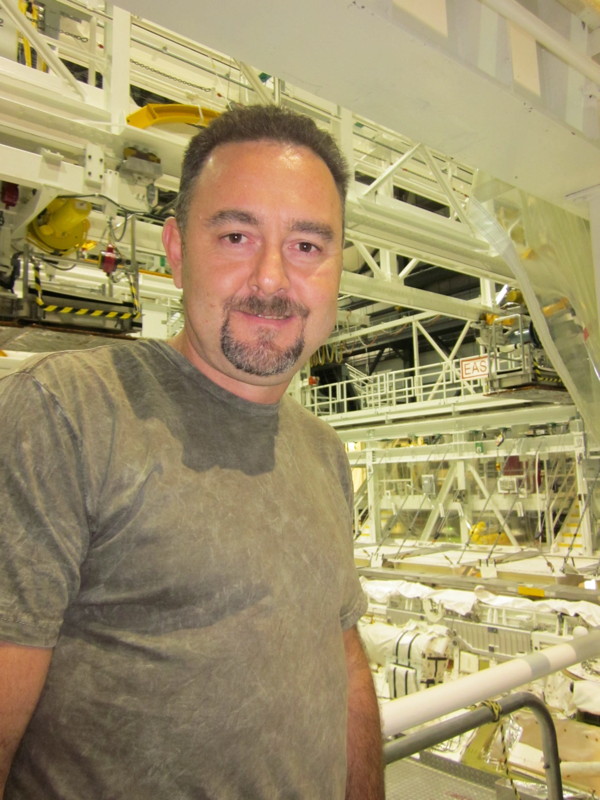Sad and Proud, Space Shuttle Workers Await Last Countdown

As NASA winds down its space shuttle program, thousands of workers are preparing to say goodbye to three spacecraft they've spent years taking care of.
The mood is bittersweet at NASA's Kennedy Space Center (KSC) in Florida, where the shuttles Discovery, Endeavour and Atlantis have launched from, and usually landed, over the last 30 years.
"It's like going out to your garage, you have an old car out there that you rebuilt yourself and you know every inch of it, you know every bolt, every washer, every little scratch on it, and you wax it every day," said Tim Keyser, a lead technician in the Orbiter Processing Facility's Mid-body Shop, who has worked on the shuttles since 1988. "That's what I do to these orbiters."
In between each flight of the reusable spaceships, thousands of engineers and technicians inspect, repair and refit them for their next go-around at orbital travel. [Photos: Inside Shuttle Discovery, a Reporter's-Eye View]
However, recently the main work at Kennedy Space Center has become preparing the orbiters for their retirement at museums, rather than flight.
NASA has one more shuttle flight planned — the July 8 liftoff of Atlantis — before all three orbiters are grounded for good. Discovery and Endeavour have already completed their final spaceflights, and are now undergoing processing for their next lives as artifacts.
Saying goodbye
Get the Space.com Newsletter
Breaking space news, the latest updates on rocket launches, skywatching events and more!
"It sucks" saying goodbye to the space shuttles, said Erin Schlichenmaier, lead thermal protection system engineer for Endeavour, who works for the NASA contractor United Space Alliance. "It's pretty sad to have them stop flying."
Yet Schlichenmaier expressed the hope that retiring the space shuttles would allow NASA to turn its attention to building new spacecraft, which has been precluded for the last three decades by the high cost of running the shuttle program. [The Most Memorable Space Shuttle Missions]
Much of that cost has come from the large number of workers required to refurbish the ships between each launch. As the program winds down, about half of the United Space Alliance employees at NASA have already been laid off.
"I have not been laid off yet, but a lot of people have," Schlichenmaier told SPACE.com. "That's really awful because it's like a family out here. We're out here all the time, we joke, you know everybody, so it's been really sad to see people go."
After the orbiters are retired, NASA plans to develop spacecraft capable of traveling to a nearby asteroid and to Mars, destinations beyond the reach of the space shuttles.
Best job in the world
Despite the sadness, most shuttle workers express pride and gratitude for the chance to be part of the shuttle program.
"You never forget that it's special, cause it is, and I'll always treasure being a part of it," said Charles Bell, another United Space Alliance employee.
He and others said they felt they had the best jobs in the world.
"I don't even look at it as a job. It's like a hobby and I get paid," said Bill Powers, a senior aerospace technician at the Orbiter Processing Facility's Forward Shop at KSC. Powers has worked on the shuttle program for 27 years, since 1984.
"I still remember the first day I saw one," he said of the shuttles, during an interview inside the cockpit of shuttle Discovery. "And part of me always flies right here behind the commander, that's where my spirit is."
Retirement homes
The space shuttles have each been assigned to retire to a different museum around the country.
Discovery is headed to the Smithsonian National Air and Space Museum's Udvar-Hazy Center outside Washington, D.C., while Endeavour will go to the California Science Center in Los Angeles, and Atlantis will make the short trip over to the visitor center at Kennedy Space Center.
Before they can be put on public display, however, the hazardous materials on the shuttle, such as the fuel and oxidizers, must be removed. NASA is also taking out some critical systems like the main engines to study and potentially reuse on future projects. These will be replaced with dummy versions so that the orbiters look exactly as they did while flying.
Though it's too bad the vehicles won't travel to space anymore, many shuttle workers said they were glad they'd serve inspirational and educational purposes now.
"We knew that was coming," Keyser said while standing on a platform overlooking shuttle Discovery's payload bay. "Hopefully, [the public] will get a better perspective about what we've done over the last 30 years with these orbiters. It's pretty good that everyone will get to see it now."
Keyser will be part of a team that travels with Discovery to the Smithsonian to help install it there.
"Luckily for me, I get to go up and actually put it where it's going to be permanently, so I'm looking forward to that," he said. Afterward, he plans to visit Discovery at the museum "yearly, as much as I can."
You can follow SPACE.com Senior Writer Clara Moskowitz on Twitter @ClaraMoskowitz. Visit SPACE.com for complete coverage of Atlantis' final mission STS-135 or follow us @Spacedotcom and on Facebook.
Join our Space Forums to keep talking space on the latest missions, night sky and more! And if you have a news tip, correction or comment, let us know at: community@space.com.

Clara Moskowitz is a science and space writer who joined the Space.com team in 2008 and served as Assistant Managing Editor from 2011 to 2013. Clara has a bachelor's degree in astronomy and physics from Wesleyan University, and a graduate certificate in science writing from the University of California, Santa Cruz. She covers everything from astronomy to human spaceflight and once aced a NASTAR suborbital spaceflight training program for space missions. Clara is currently Associate Editor of Scientific American. To see her latest project is, follow Clara on Twitter.










